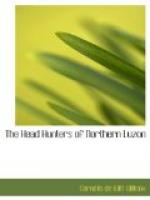There were many women and children, the children very shy. Of weapons there were none. Dancing went on uninterruptedly the whole day and night of our stay, and Cootes and I had to dance again. Only we had now arranged to simulate a boxing-match, which we presented to the beat of the gansa, and to the applause of our gallery. A runner came in while we were here, carrying a note in a cleft stick, the native substitute for a pocket. In dress and appearance, the Andangle people differed in no wise from those of Kiangan. Many of them, however, have a silver jewel, of curious and original design, worn chiefly as earring, but also on a string around the neck. Our splendid chief at Payawan also wore many of these jewels, but his were of gold. Mr. Worcester distributed his white slips to the ever-eager multitudes, listened to reports, and held council with the head men; the people were fed with rice and meat, appeared thoroughly to enjoy themselves, and so the time passed.
The next morning, May 4th, we rode off. Shortly after leaving, we came suddenly upon a party apparently wrangling over a piece of meat, at a point where the trail was crossed by a small stream, flowing in a thin sheet over a smooth face of rock, twenty or more feet high, and tilted at about seventy degrees. The wranglers took alarm on our approach and scattered in all directions. One of them, a boy of perhaps sixteen, ran up the rock just described at full speed on his toes, and disappeared in the bushes at the top. Even if he had wished to use his hands, there was nothing to lay hold on. If I had not seen it performed with my own eyes, I should have declared the feat impossible: I mention it to mark the agility and strength of these people. Bear in mind that this youngster ran up, that the rock was not far from the vertical, and that the water-worn face was smooth and slippery. The thing was simply amazing.
We stopped again at our rest-house of the day before, meeting a few cabecillas, who showed us, with much pride, long ebony canes with silver tops, and inscriptions showing that they had been given by the Spanish Sovereign as rewards for faithful service, etc. One of these canes had been given by Maria Cristina. Others produced, from bamboo tubes, parchments of equally royal origin, setting forth in grandiloquent Spanish the confidence reposed by the Sovereign in such and such a cabecilla.
This day’s journey was without incident of any sort. But, like all our other rides, it took us through country that beggars one’s powers of description. We rode part of the way through an open forest, many of whose trees were of great height. One of these had, on a single large branch thrust out from the trunk at a height of sixty feet or so, as many bird’s-nest ferns as could crowd upon it, looking comically like a row of hens roosting for the night. From the ground, about fifteen feet from the root of this same tree, rose a single-stem liana, joining the main trunk at the branch just mentioned; to this liana a huge bird-nest fern had attached itself twenty feet or more above the ground, completely surrounding the stem, a singular sight.




